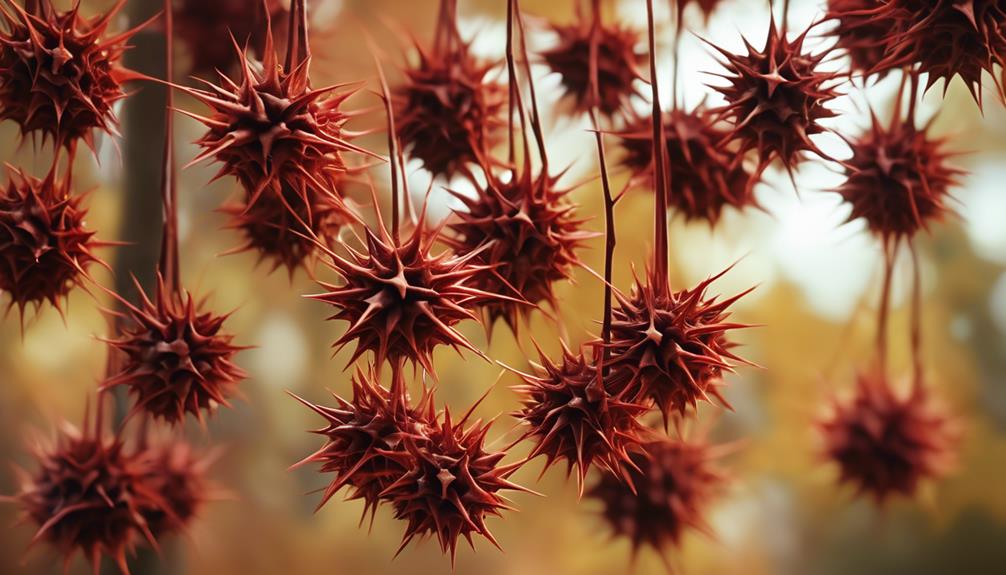Are Sweetgum Trees Good for Anything
Did you know that sweetgum trees have a variety of practical uses? From its wood being used in the pulp and paper industry to its medicinal properties, sweetgum trees offer more than just shade.
The question of whether sweetgum trees are good for anything may arise, and in this discussion, we will explore the different ways sweetgum trees can be beneficial.
So, let's dive into the fascinating world of sweetgum trees and discover the hidden potentials that lie within their bark, leaves, and wood.
Medicinal Properties of Sweetgum

Discover the incredible medicinal properties of sweetgum, a tree that has been used for centuries to treat a wide range of ailments.
Sweetgum trees are considered valuable medicinal plants due to the various compounds found in their leaves, bark, and seeds. One of these compounds is shikimic acid, which is a precursor to the production of oseltamivir phosphate, the active ingredient in Tamiflu.
This acid, along with other beneficial compounds, makes sweetgum extracts potential antioxidants, anti-inflammatory agents, and chemopreventive agents. Additionally, studies have shown that the compounds in sweetgum extracts can suppress hypertension in mice and have anticonvulsant effects.
The resinous sap of sweetgum trees, known as storax, has also been used for centuries to treat common ailments such as skin problems, coughs, and ulcers. Storax has even proven to be effective against multidrug-resistant bacteria, making sweetgum a valuable resource for medicinal purposes.
Benefits for Hardwood Growth
If you're interested in hardwood growth, you'll be pleased to know that sweetgum trees offer several benefits.
The desirable reddish heartwood produced by sweetgum trees contributes to the growth of hardwood resources. This wood is highly valued in the pulp and paper industry, supporting the growth of the hardwood industry.
Additionally, sweetgum trees can be grown in a variety of sites, providing versatile options for hardwood growth.
Hardwood Growth Advantages
To maximize the growth and potential of hardwood, sweetgum trees offer a range of advantages that make them an ideal choice for forestry and biomass production.
Sweetgum trees, also known as Liquidambar styraciflua, are a hardwood species that possess unique properties beneficial for hardwood growth.
One of the key advantages of sweetgum is its interlocked grain, which provides strength and stability to the wood, making it highly resistant to warping and splitting.
Additionally, sweetgum trees have a rapid growth rate, allowing for a shorter rotation period compared to other hardwood species. This means that more timber can be harvested in a shorter amount of time, increasing productivity and profitability.
Furthermore, sweetgum trees can be grown in various soil types, making them adaptable to different environments.
Benefits for Hardwood Production
Sweetgum trees offer a multitude of benefits for hardwood production, making them a valuable resource in the forestry and biomass industry. These trees produce desirable reddish heartwood, which is highly sought after for hardwood production. The pulp and paper industry also benefits from sweetgum trees, as they provide a source of high-quality wood for paper production.
Moreover, sweetgum trees are used in the production of veneer and lumber, contributing to the hardwood industry for various applications. One of the advantages of sweetgum trees is their ability to grow in both upland and bottomland sites, offering versatility for hardwood growth in different environments. Additionally, hybrid sweetgum trees demonstrate exceptional volume gains for biomass production, making them valuable for sustainable hardwood production.
With all these benefits, sweetgum trees are undoubtedly a valuable asset in the hardwood industry.
Ornamental and Landscaping Uses

When it comes to landscaping and adding beauty to your outdoor space, few trees can compare to the ornamental appeal of sweetgum trees. With their tall and ovular shape, sweetgum trees make excellent shade trees, providing a cool respite on hot summer days.
But it's not just their shape that makes them stand out. In the fall, the leaves of sweetgum trees transform into a stunning display of orange, red, and yellow, adding a burst of color to any landscape. Not only are they aesthetically pleasing, but sweetgum trees also serve as a source of food for various species.
Their spikey gum balls provide nourishment for birds, squirrels, chipmunks, and even ducks. Additionally, their unique shape and texture make sweetgum balls great for crafts and decorative items, adding an extra touch of charm to your outdoor space.
Sweet Gum Lumber
Sweet gum lumber, with its dark and rich color, is prized for its versatility in crafting speaker boxes, furniture, cabinetry, and doors. It's a popular choice among woodworkers due to its aesthetic appeal and durability. Despite its challenges, such as warping during the drying process caused by the interlocked grain, sweet gum wood is highly valued in the Southeastern United States for its potential in creating beautiful and long-lasting items.
The unique color of sweet gum lumber adds warmth and sophistication to any space. Its durability ensures that furniture and cabinetry made from sweet gum wood will stand the test of time. Sweet gum lumber is an environmentally friendly choice, as it comes from sustainable sources.
With its many uses and benefits, sweet gum lumber is a fantastic option for those seeking quality craftsmanship and timeless beauty in their woodworking projects.
Edible Uses

Did you know that sweetgum trees have edible uses? The resin produced by these trees, known as storax, has been used for flavoring and even has medicinal properties.
In fact, the dried sap of sweetgum trees can be chewed to make gum. So not only can these trees provide shade and beauty, but they also offer some tasty and potentially beneficial treats.
Culinary Applications
To fully explore the culinary applications of Sweet Gum trees, let's delve into the edible uses of this versatile plant.
The dried sap of Sweet Gum trees is considered edible and can be used to make chewing gum by slicing the cambrian layer of bark.
Boiling the young green seeds from Sweet Gum balls can create a tea with potential antiviral properties. Sweet Gum balls contain shikimic acid, which is also found in Tamiflu®, and has various health benefits.
These edible uses of Sweet Gum trees offer a range of possibilities for incorporating this plant into your culinary repertoire.
From making your own chewing gum to brewing a health-promoting tea, Sweet Gum trees provide unique and interesting options for experimentation in the kitchen.
Medicinal Properties
Now, let's explore the medicinal properties of Sweet Gum trees by discovering their edible uses.
Sweetgum trees are a valuable source of shikimic acid, a key ingredient used in the production of oseltamivir phosphate, the active ingredient in Tamiflu. The leaves, bark, and seeds of the sweetgum contain this beneficial compound.
Extracts from sweetgum have shown potential as antioxidants, anti-inflammatory agents, and chemopreventive agents. These compounds have also been found to suppress hypertension in mice and have anticonvulsant effects.
Additionally, sweetgum extracts possess antifungal activity against various phytopathogenic fungi, making them useful as environment-friendly pesticides and antifungal agents.
The medicinal properties of sweetgum trees make them a valuable resource in the field of natural medicine.
Ecological Benefits
Sweetgum trees play a vital role in their ecosystems, providing a host of ecological benefits that support a diverse range of plant and animal species. Here are some of the ways in which sweetgum trees contribute to the environment:
- Sweetgum trees contain shikimic acid, a compound often used in the pharmaceutical industry to produce antiviral medications. This highlights their potential in helping combat viral infections and improve human health.
- Despite their infertile seeds, sweetgum trees have a widespread distribution. This allows them to establish themselves in various habitats, supporting biodiversity and creating valuable habitats for wildlife.
- Sweetgum trees are often used as shade trees in urban areas, providing relief from the heat and reducing energy consumption for cooling buildings. This not only benefits humans but also helps maintain a balanced ecosystem.
Antifungal Properties

Did you know that sweetgum trees have natural compounds that possess antifungal properties?
These compounds have been found to be effective against various phytopathogenic fungi, making sweetgum extracts potential environment-friendly pesticides and antifungal agents.
Further research on sweetgum trees could lead to the development of new antifungal products and potential applications in the medical field.
Natural Antifungal Compounds
With their remarkable antifungal properties, sweetgum extracts offer a natural and effective solution for combating fungal infections.
The leaves, bark, and seeds of the Sweetgum tree, scientifically known as Liquidambar styraciflua L., contain beneficial compounds with antifungal activity. These compounds have been found to be effective against various phytopathogenic fungi, making sweetgum extracts a valuable tool for farmers and gardeners.
Not only can sweetgum extracts combat fungal infections, but they also have the potential to reduce nematodes and mosquito populations due to their antifungal properties.
Potential Medical Applications
As we explore the potential medical applications of sweetgum extracts, it becomes evident that their antifungal properties offer promising natural alternatives for treating a range of fungal-related skin problems and infections.
Sweetgum trees, native to North America, are deciduous trees closely related to red oaks. Their extracts have shown significant antifungal activity against various phytopathogenic fungi, making them potential candidates for natural fungicides.
The resinous sap of sweetgum trees, known as storax, also possesses antimicrobial properties that suggest its potential in combating fungal infections.
This research indicates that sweetgum extracts may hold great promise in developing new antifungal medications and treatments.
With their remarkable antifungal properties, sweetgum trees could be a valuable resource in exploring natural remedies for fungal ailments.
Pesticidal Uses
Sweetgum trees offer a multitude of benefits, and one of the most intriguing is their pesticidal uses. These remarkable trees have been found to possess antifungal activity against various phytopathogenic fungi, making them a valuable tool in combating plant diseases.
Additionally, sweetgum extracts have been proven to be effective treatments for reducing nematode and mosquito populations. This means that sweetgum trees can be used as environmentally friendly pesticides and antifungal agents, providing a natural and sustainable alternative to harmful chemical treatments.
Furthermore, the pesticidal properties of sweetgum trees have contextually relevant applications in agriculture and public health, making them a valuable resource for pest control. So, not only are sweetgum trees good for the environment, but they also have practical uses in this important article section.
Sweet Gum Ball Solutions

To explore the potential solutions offered by sweet gum balls, let's now turn our attention to the remarkable properties contained within these natural spheres.
Sweet gum balls, the woody seedpods of the sweetgum tree, have been recognized for their medicinal benefits. One notable compound found in these balls is shikimic acid, which is also present in Tamiflu®. Boiling the young green seeds can create a tea with antiviral properties, providing a natural remedy for certain viral infections.
Additionally, resins and extracts from sweet gum trees possess a variety of health benefits. These balls have been found to possess antibacterial, antifungal, antioxidant, and anti-inflammatory properties. They can aid in wound healing and even have antihypertensive and anticoagulant effects.
With these impressive attributes, sweet gum balls offer an array of potential solutions for various health issues.
Other Practical Applications
Unlock the hidden potential of sweet gum trees by exploring their numerous practical applications.
Sweetgum extracts can be used as environment-friendly pesticides and antifungal agents, ensuring a greener approach to agriculture.
Additionally, sweetgum trees offer potential for biomass and cellulosic ethanol production, providing alternative economical uses and contributing to the renewable energy sector.
Furthermore, research on sweetgum trees can lead to the development of value-added products, opening doors for innovation and economic growth.
Sweetgum wood can be repurposed for making chopsticks, toothbrushes, utensils, and camp amenities, reducing the demand for traditional materials.
Moreover, the woody seedpods of sweetgum trees can be transformed into chewing gum, offering a sustainable alternative to synthetic gum.
Unleash the diverse practical applications of sweetgum trees and embrace their contributions to a more sustainable future.
Conclusion
In conclusion, sweetgum trees offer a multitude of practical uses and benefits.
From their medicinal properties to their use in the pulp and paper industry, sweetgum trees prove to be valuable resources. They also serve as great shade trees in landscaping and their wood is highly sought after for veneer and lumber.
With their antimicrobial and anti-inflammatory properties, sweetgum leaves, bark, and seeds offer potential health benefits.
Overall, sweetgum trees are a valuable asset in various industries and landscapes.







